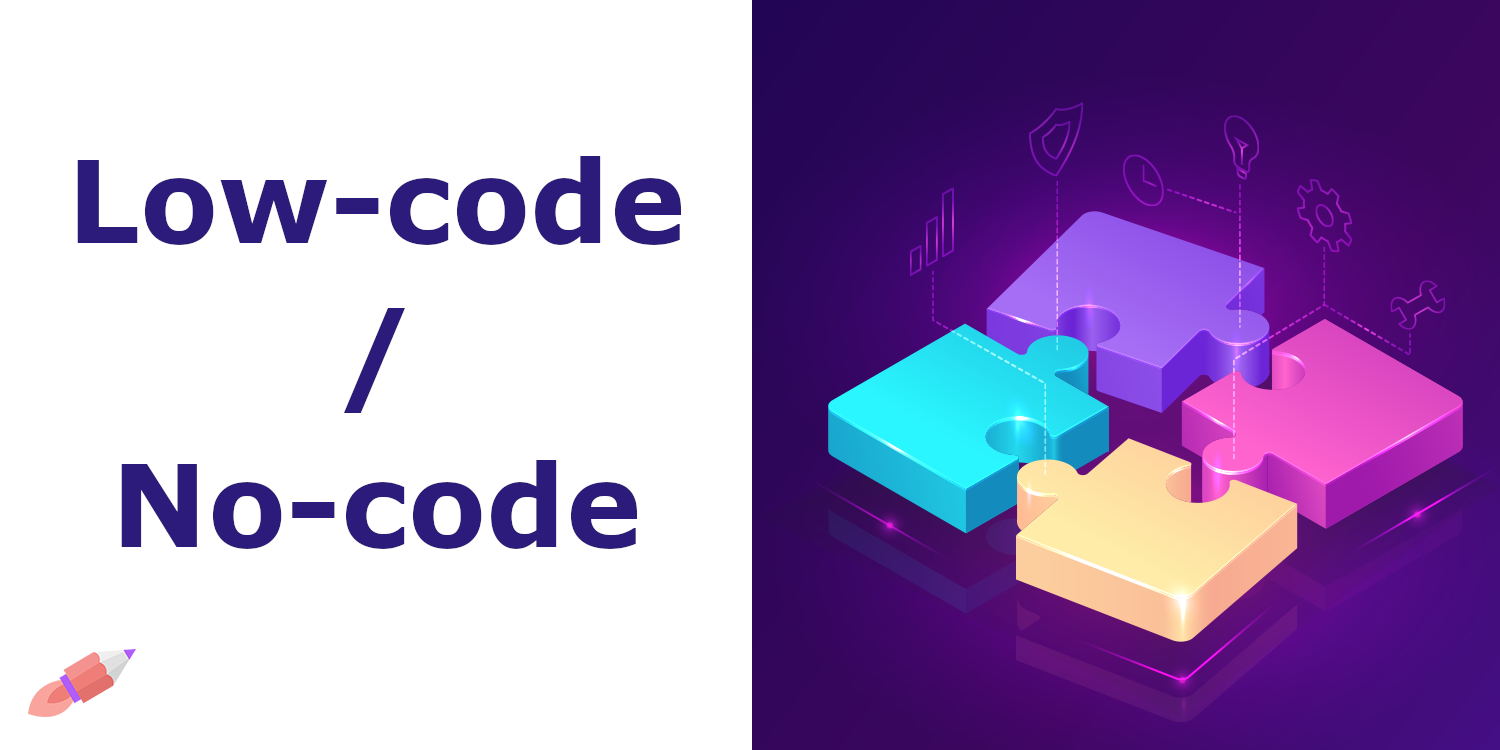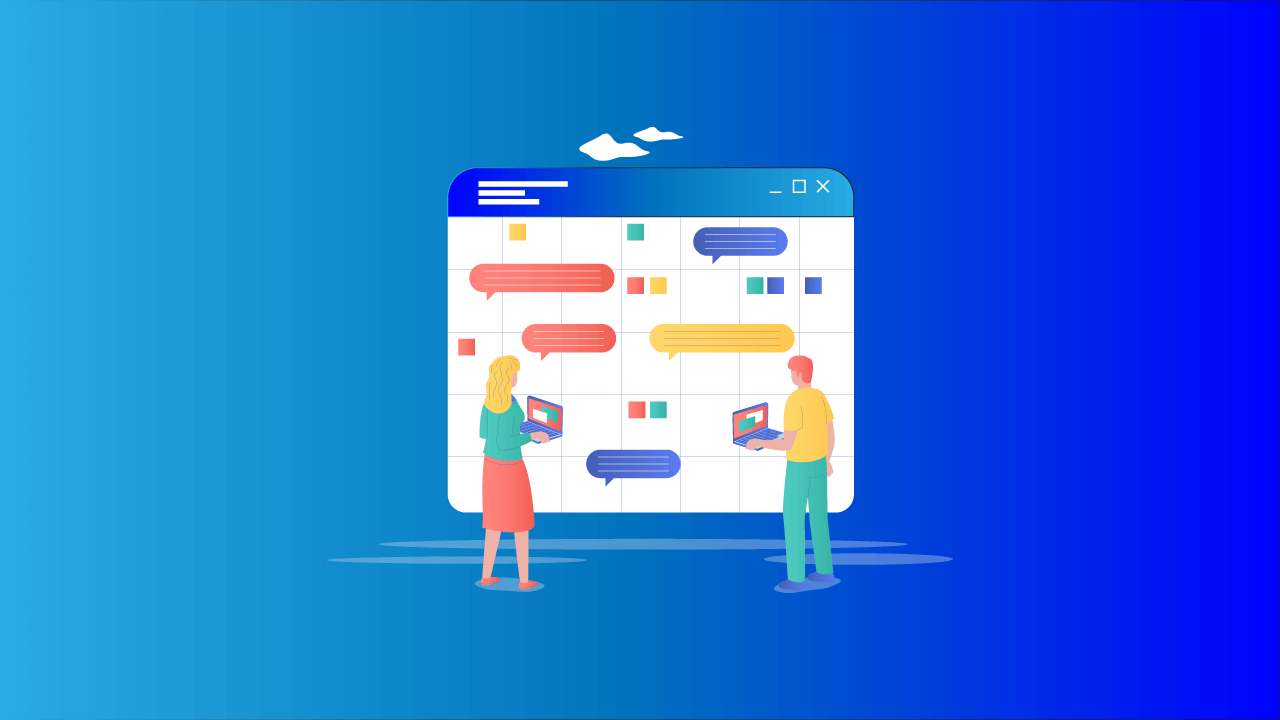The terms low-code and no-code are often misunderstood to be the same thing when in reality, they refer to two completely different solutions for app development.
It’s not uncommon for even experienced business users to mix them up since some low-code platforms offer no-code capabilities, and similarly, some no-code tools have built-in low-code options.

If you’re looking for information on the distinction between low-code and no-code platforms, you’ve come to the right place.
This guide covers everything from clear definitions of each option to differences between them, the pros and cons of no-code/low-code platforms, and even recommends the best ones for development.
What is Low Code?
Low-code platforms make it easier for developers of all skill levels to quickly and efficiently create applications with minimal coding effort.
Instead of spending time writing code from scratch, no-code platforms provide more efficient shortcuts that allow users to take advantage of the already built-in software elements and infrastructure. This makes it much simpler and quicker for developers to build their applications.
Low-code platforms use a Rapid App Development (RAD) methodology, incorporating automated code construction through drag-and-drop interfaces, pull-down menus, and other graphical elements.
Developers can then focus their efforts on creating the distinct parts of the application that make it stand out from competitors. At the same time, the platform handles all the necessary boilerplate and similar code.
As a developer, you can still add your custom code to the automated code generated by a low-code tool.
What is No Code?
No-code development provides an unparalleled opportunity for people without coding experience or technical knowledge. With it, these individuals can develop apps without writing a single line of code.
This has made it possible for citizen developers to create business applications, entrepreneurs to launch websites, and business owners to develop mobile apps that can take their businesses to the next level.
No-code development is a RAD approach that requires no coding or programming skills. Instead, it employs visual tools, plugins, modules, and drag-and-drop builders to craft applications. Thanks to these user-friendly features, anyone with basic web browsing knowledge can create an app on a no-code platform without needing specialized training.
What’s the Difference Between Low Code and No Code?
We can draw parallels between low-code development platforms and no-code app makers. However, when we dive deeper into the specifics of each, it’s easy to spot the apparent distinctions. Let’s break down the differences between these two approaches below
End-User
Low-code solutions are intended for professional developers with some programming and development knowledge. However, they provide a simpler alternative to coding from the ground up.
Anyone can employ a no-code platform, even those without any technical background. For experienced developers, a low-code system is more suitable as it allows them to leverage their expertise.
Open vs. Closed System
Low code leverages open systems, which enable users to customize applications by writing code. Developers can develop a custom plugin or feature on an open system and then reuse the same code for another project down the line.
On the other hand, traditional no-code platforms are closed, so one has to rely solely on pre-built plugins and templates that cannot be customized beyond the platform’s capacity.
Mobiroller, a no-code app development platform, is also developer friendly. If you’re looking for a custom feature for your application that isn’t available through plugins you can have a developer create it for you using Mobiroller’s open system.
Other no-code platforms can’t compete with Mobiroller regarding flexibility and customization, making it the top choice for app-building software.
Speed
Low-code development is faster than the traditional approach, but it requires more training and onboarding to take a project from development to deployment. No-code solutions can get applications to market even quicker; however, specialized skills are needed for low-code development.
No-code tools offer a plug-and-play solution that requires minimal effort to customize and make your own. Moreover, the risk of errors due to manual coding is significantly reduced, meaning you won’t have to spend too much time testing the app.
Use Cases
Low-code development is often favored for creating software and applications related to business process management, business workflows, internal business apps, and software for custom integrations. It provides a reliable solution for professional developers seeking to create tailored solutions for their employers. Meanwhile, no-code can be used to develop various software and applications.

No-code development is an incredibly versatile tool that can create various applications, from education apps to event apps to fitness and health programs. The idea behind it is simple – take advantage of as much pre-built functionality as possible.
For instance, when creating an ecommerce app, you will want the same basic features, such as a shopping cart, payment portal, and user profile. Your task is then to personalize the content and design with your branding.
Low-code and no-code tools won’t cut it if you’re looking to create a graphics-intensive app, AR/VR app, or game. Traditional development is better suited for these types of applications. For example, if you’re aiming to build the next Facebook or YouTube, consider traditional development instead.
What is a Low Code Development Platform?
A low-code development platform utilizes visual tools and process modeling to create rules, workflows, and user interfaces converted into code at the backend. Developers look to this type of platform when they need to streamline their coding efforts and focus more on customization.

The visuals are what makes it so efficient. Low-code platforms give you the framework and structure for creating applications. This includes databases and elements frequently used in all programs, which can be activated or deactivated depending on your needs.
Using this tool, 90% of the coding can be done automatically, and the remaining 10% can be customized with custom code.
How Do No Code Development Platforms Work?
No-code development does not require any coding experience, unlike low-code platforms. Instead, no-code relies entirely on the visual building from the front end. Begin with a template and add content in simple text, alter colors, incorporate videos, and control design via a visual editor. To add functionality, install plugins or activate functions.
If you’re a personal trainer, no-code app builders can make it easy to provide mobile training to your clients. You can quickly and easily add videos of workouts with plugins for YouTube or Vimeo. Select the videos you want to include and where they should be in the app. Plus, if you need a booking feature for clients to schedule appointments, there’s a plugin.
You may be looking for an interactive map to guide customers to the gym you manage. That’s easy to set up with our no-code platform. All the necessary features are already built into it, so you can add whatever extra functions you need to make your app stand out from the rest. It’s just a few clicks away!
Pros and Cons of Low Cow Code Development Platforms
Let’s dive deeper into the pros and cons of leveraging low-code tools for application development.
Low-Code Pros
- No-code solutions make it easier to build apps across multiple platforms.
- Reduces the need for waiting on other developers to finish building parts of the app since most basics are already coded.
- Low-code development carries fewer risks, resulting in less money spent and higher ROI.
Low-Code Cons
- Low-code platforms require development knowledge for use.
- Scalability for enterprise apps can be limited.
- Making significant changes within the platform itself may take work.
Pros and Cons of No Code Platforms
No-code software development is becoming increasingly popular for many different applications. However, before you start, it is essential to bear the following in mind:
No-Code Pros
- No-code platforms allow anyone to develop an app with no coding skills necessary.
- It’s the fastest and most cost-effective way to create an app – no need for a development team! Both iOS and Android apps can be built with no-code tools.
- Single-click deployment to both App Stores.
No-Code Cons
- No-code tools may limit your capabilities and prevent you from fully customizing your app.
- Low-grade app builders are unsuitable for creating games
- in augmented reality (AR), virtual reality (VR), or any high-tech and complex apps like Facebook, Tinder, or Uber.
Best Low-Code/No-Code Development Platform For Mobile Apps
Mobiroller is the most advanced low-code/no-code development platform for iOS and Android, empowering developers with the tools to create custom functionality from scratch. Where regular no-code app builders can fall short, Mobiroller offers unlimited scale and customization options – making it one of the best no-code development tools available Today.
With Mobiroller, your app infrastructure and backend services are taken care of. There is no need to fret over securing servers or managing databases on the backend to maintain your app. The no-code visual editor allows you to easily customize your app, while the emulator quickly shows any changes you make in real-time.
The platform is 100% web-based and requires no installation, making it simple to create an app using Mobiroller. Getting the features you need is also a breeze – pick from the 150+ plugins available in the Mobiroller Dashboard.
Suppose you need something that isn’t available as a plugin, no worries! Using Mobiroller’s SDK, your developers can create custom plugins and features with low-code technology. Don’t have any developers? Reach out to Mobiroller, and our in-house development team can create it for you. Mobiroller is unique for no-code/low-code app development on the market!
QUESTIONS AND ANSWERS
What are the advantages of no-code software development?
The advantages of no-code software development include faster and more cost-effective app creation, single-click deployment to both App Stores, and anyone can develop an app without coding experience.
What is Mobiroller?
Mobiroller is the most advanced low-code/no-code development platform for iOS and Android, empowering developers with the tools to create custom functionality from scratch. It offers unlimited scale and customization options, taking care of app infrastructure and backend services, as well as offering 150+ plugins.
What is the difference between no-code and low-code?
No-code tools are designed to allow developers to create an app with limited customization capabilities, while low-code tools provide more flexibility in terms of customizing the app. Low-code solutions also offer a more comprehensive range of features than no-code solutions. In addition, low-code apps can be created by non-developers as well.
What makes Mobiroller unique?
Mobiroller is the only no-code/low-code app development platform that offers both a visual editor and an SDK for developers to create custom plugins and features with low-code technology. It also provides all necessary backend services, such as server security and database management, without needing additional third-party services. It is also 100% web-based and requires no installation, making it easier to start an app immediately.
What are the benefits of using a Mobiroller?
The benefits of using Mobiroller include faster time to market, lower cost compared to traditional development, scalability, access to 150+ plugins in the marketplace, and custom development options with its SDK. Business users also trust it with coding experience and professional developers.
CONCLUSION
Gone are the days when you needed to code software manually from scratch. Low-code/no-code app development solutions make it much easier for developers, citizen developers, and anyone else to create an app quickly. With these tools, apps can be deployed in weeks or months at a fraction of the cost compared to traditional development. Although no-code and low-code app development tools share some similarities, they are ultimately two very different solutions. If you’re confused about which one suits your needs better, try Mobiroller – the perfect combination of both! Trusted by business users with no coding experience and professional developers, sign up Today!








